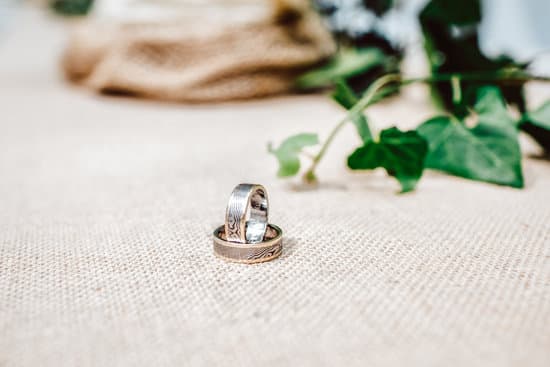Are you wondering about the age-old question, “A wedding ring goes on which hand?” The tradition and symbolism of the wedding ring hold significant meaning for many cultures around the world.
It’s not just a piece of jewelry; it represents love, commitment, and unity between two people. In this article, we will explore the historical origin of wearing wedding rings, cultural differences in wedding ring placement, the significance of wearing a wedding ring on the left hand, and much more.
The tradition of exchanging wedding rings dates back thousands of years to ancient Egypt and Rome. These symbolic bands are worn on the fourth finger of the left hand because it was believed that a vein in that finger led directly to the heart. This historical origin has influenced various cultural customs and beliefs about where and how wedding rings should be worn.
Cultural differences in wedding ring placement vary across different regions and societies. While many Western countries traditionally wear wedding rings on the left hand, other cultures may opt for right-hand placement. The significance behind these choices often reflects religious or historical influences that have been passed down through generations. Understanding these cultural nuances adds depth to the meaning behind wearing a wedding ring.
The Historical Origin of Wearing Wedding Rings
The tradition of wearing wedding rings dates back to ancient Egypt, where couples exchanged rings made from braided reeds. These rings were worn on the fourth finger of the left hand, as it was believed to contain a vein that led directly to the heart, symbolizing the eternal bond and love between the couple. This tradition then spread to other cultures, including the Romans and Greeks, who also adopted the custom of wearing wedding rings on the left hand.
In medieval Europe, Christian ceremonies formalized the practice of wearing wedding rings as a symbol of unity and commitment. The rings were often inscribed with romantic phrases or names, further solidifying their significance as a representation of love and fidelity. Over time, this tradition became deeply ingrained in Western culture and continues to be an important part of wedding ceremonies today.
Cultural differences have also influenced the historical origin of wearing wedding rings, with some cultures placing more emphasis on different fingers for ring placement. In some Eastern European countries such as Russia and Greece, it is customary to wear the wedding ring on the right hand. This difference in tradition adds diversity and richness to the history and symbolism of wedding rings across various cultures.
- Wedding rings made from braided reeds
- The tradition spreading to other cultures
- Christian ceremonies formalizing the practice
Cultural Differences in Wedding Ring Placement
When it comes to cultural differences in wedding ring placement, there are various customs and traditions around the world. Different cultures have their own unique ways of wearing wedding rings, which can signify different meanings and beliefs. Here are some examples of cultural differences in wedding ring placement:
- In Western countries such as the United States, Canada, and most European nations, it is customary to wear a wedding ring on the left hand. This tradition dates back to ancient Roman times when it was believed that there was a vein that ran directly from the fourth finger of the left hand to the heart, known as the “vena amoris” or “vein of love.”
- In many Eastern European and some South American countries, however, it is common for people to wear their wedding rings on their right hand. For example, in Russia and Poland, couples typically exchange rings during the wedding ceremony and wear them on their right hands. This custom is deeply rooted in these cultures’ history and has been passed down through generations.
- In some Asian countries such as India and China, there is no set rule for which hand to wear a wedding ring on. Some couples may choose to wear their rings on their left hand, while others may opt for the right hand based on personal preference or family traditions.
Overall, it’s important to recognize that customs surrounding wedding ring placement vary greatly across different cultures around the world. Understanding these cultural differences can help individuals appreciate the diversity of practices related to marriage and symbolize unity within different communities across the globe.
The Significance of Wearing a Wedding Ring on the Left Hand
Historical and Traditional Meaning
The tradition of wearing a wedding ring on the left hand can be traced back to ancient Egypt, where it was believed that the “vein of love” ran directly from the heart to the fourth finger of the left hand. This symbolic significance has been carried through various cultures and has become a widely accepted practice in many parts of the world.
In Western cultures, including North America and Europe, wearing a wedding ring on the left hand is seen as a symbol of commitment and love between partners. It signifies the bond between two individuals who have chosen to spend their lives together in marriage. The act of placing the ring on this specific finger is deeply rooted in historical customs and continues to hold sentimental value for many couples.
Modern Interpretations
In contemporary society, the placement of the wedding ring on the left hand continues to hold significance. Many couples view it as a public display of their commitment to each other, and as a way to express their dedication and loyalty within their relationship. Some also believe that wearing the wedding ring on the left hand creates a strong sense of unity as it is commonly associated with marriage traditions.
However, it is important to note that while there is symbolism attached to wearing a wedding ring on the left hand, personal preferences may vary. Some cultural differences exist in which hand is used for wearing a wedding ring, reflecting diverse interpretations and customs across different societies. Nevertheless, for many people worldwide, placing a wedding ring on the left hand remains an enduring representation of love and fidelity within marriage.
The Meaning of Wearing a Wedding Ring on the Right Hand
The placement of a wedding ring on the right hand holds various meanings and significance in different cultures and traditions. In some countries, wearing a wedding ring on the right hand signifies a couple’s engagement or indicates that the individual is still unmarried. This tradition is particularly common in Eastern European and South American countries, where the right-hand placement symbolizes an upcoming union or commitment.
Symbolism in Different Cultures
In India, for example, it is customary for women to wear their wedding ring on the right hand. This practice is rooted in ancient astrology and cultural beliefs, with the left hand being associated with negative energy. Similarly, in certain parts of Europe, such as Greece and Germany, the right-hand placement is seen as a reflection of the individual’s single status or imminent marriage.
Personal Preferences and Modern Trends
While traditional customs dictate the placement of a wedding ring on the left hand in many Western societies, there has been a growing trend of individuals choosing to wear their wedding ring on the right hand simply based on personal preference or style. Some couples may opt for this unconventional approach as a way to honor their partner’s heritage or as a statement of independence within their marriage.
Additionally, modern jewelry designs now cater to this trend by offering versatile rings that can be worn on either hand without compromising symbolism or sentimentality.
Overall, whether one chooses to wear their wedding ring on the left or right hand ultimately depends on personal beliefs, cultural influences, and individual preferences. Both placements hold deep symbolism and continue to carry significant meaning in different parts of the world. Understanding these diverse traditions adds depth and richness to the universal symbol of love and commitment that a wedding ring represents.
How to Properly Wear and Care for a Wedding Ring
Wearing a wedding ring is a tradition that symbolizes the eternal bond and commitment between spouses. The exchange of rings during a wedding ceremony is a timeless ritual that signifies the couple’s love and devotion to each other. But knowing how to properly wear and care for a wedding ring is equally important in preserving its symbolism and significance.
One common question that many people have is, “Which hand does the wedding ring go on?” In most Western cultures, including the United States, Canada, and the United Kingdom, the wedding ring is traditionally worn on the left hand. This tradition dates back centuries and has been passed down through generations as a symbol of love and fidelity.
When it comes to caring for a wedding ring, proper maintenance is essential to ensure that it retains its luster and beauty for years to come. Regular cleaning with mild soap and water, as well as periodic professional polishing, can help keep the ring looking its best. Additionally, storing the ring in a safe place when not being worn can prevent damage or loss.
| Country | Traditional Hand for Wedding Ring |
|---|---|
| United States | Left Hand |
| Canada | Left Hand |
| United Kingdom | Left Hand |
Common Misconceptions About the Placement of Wedding Rings
There are several common misconceptions when it comes to the placement of wedding rings, and one of the most prevalent is the belief that there is a universal rule dictating which hand a wedding ring should be worn on. In reality, the tradition of wearing a wedding ring on a specific hand varies greatly across different cultures and time periods.
One common misconception is that all countries follow the custom of wearing the wedding ring on the left hand. While this practice is indeed popular in many Western cultures, it is not universal. In some countries, such as Russia and Germany, it is customary to wear the wedding ring on the right hand. Additionally, in some Eastern European and Asian cultures, both partners wear their wedding rings on their right hands.
Another common misconception is that wearing a wedding ring on a particular hand carries a specific meaning or symbolism that applies universally. While there may be certain cultural or religious associations with wearing a wedding ring on a certain hand, these meanings can vary widely between different societies and belief systems.
It’s important for couples to discuss and decide together where they want to wear their wedding rings based on their own personal beliefs, traditions, and preferences. The significance of wearing a wedding ring should be deeply personal and meaningful to each individual couple, regardless of any supposed rules or misconceptions surrounding its placement.
Modern Trends in Wedding Ring Placement and Design
In conclusion, the placement of a wedding ring holds deep cultural and historical significance. While the tradition of wearing a wedding ring on the left hand is widely practiced, there are also various cultural differences and modern trends to consider. Understanding the symbolism behind the placement of a wedding ring can help couples make an informed decision that reflects their beliefs and values.
As we have explored the historical origin of wedding rings and the significance of wearing them on different hands, it is important to note that there are no strict rules when it comes to this tradition. Many couples today are choosing to personalize their wedding ring placement based on their cultural background or personal preferences. This flexibility allows for a more meaningful and unique expression of commitment.
Additionally, with modern trends in wedding ring design, individuals now have more options than ever before. From personalized engravings to unconventional materials, such as wood or mixed metals, couples can find or create a wedding ring that truly speaks to their individuality. Ultimately, whether a wedding ring goes on the left hand or right hand is a decision shaped by tradition, culture, and personal choice, making it a deeply personal symbol of love and commitment.
Frequently Asked Questions
What Does Wedding Ring on Right Hand Mean?
In some cultures, wearing a wedding ring on the right hand can have different meanings. In some Eastern European countries, it signifies that a person is engaged or married.
In other places, it could symbolize a more non-traditional approach to marriage or a same-sex marriage. Ultimately, the meaning of wearing a wedding ring on the right hand varies depending on cultural and personal beliefs.
Why Do Europeans Wear Wedding Ring on Right Hand?
The tradition of wearing wedding rings on the right hand in Europe dates back to ancient times. It is believed that the Romans were the first to adopt this practice, as they considered the left hand to be less important than the right.
Over time, this custom has become deeply embedded in European culture and continues to be practiced by many couples today.
Does the Male Wedding Ring Go on the Left or Right Hand?
Traditionally, the male wedding ring is worn on the left hand. This has been the prevailing custom in Western cultures for many years, and it is still widely observed today.
However, there are no hard and fast rules when it comes to which hand a man should wear his wedding ring on – ultimately, it comes down to personal preference and cultural traditions.

I have been involved in marriages for over 20 years helping couples and singles understand more about them.





